1969 Spanish Grand Prix race report: Stewart goes the distance
Jackie Stewart’s Matra outlasts both the Lotus of Jochen Rindt and Chris Amon's Ferrari to take his second win in a row
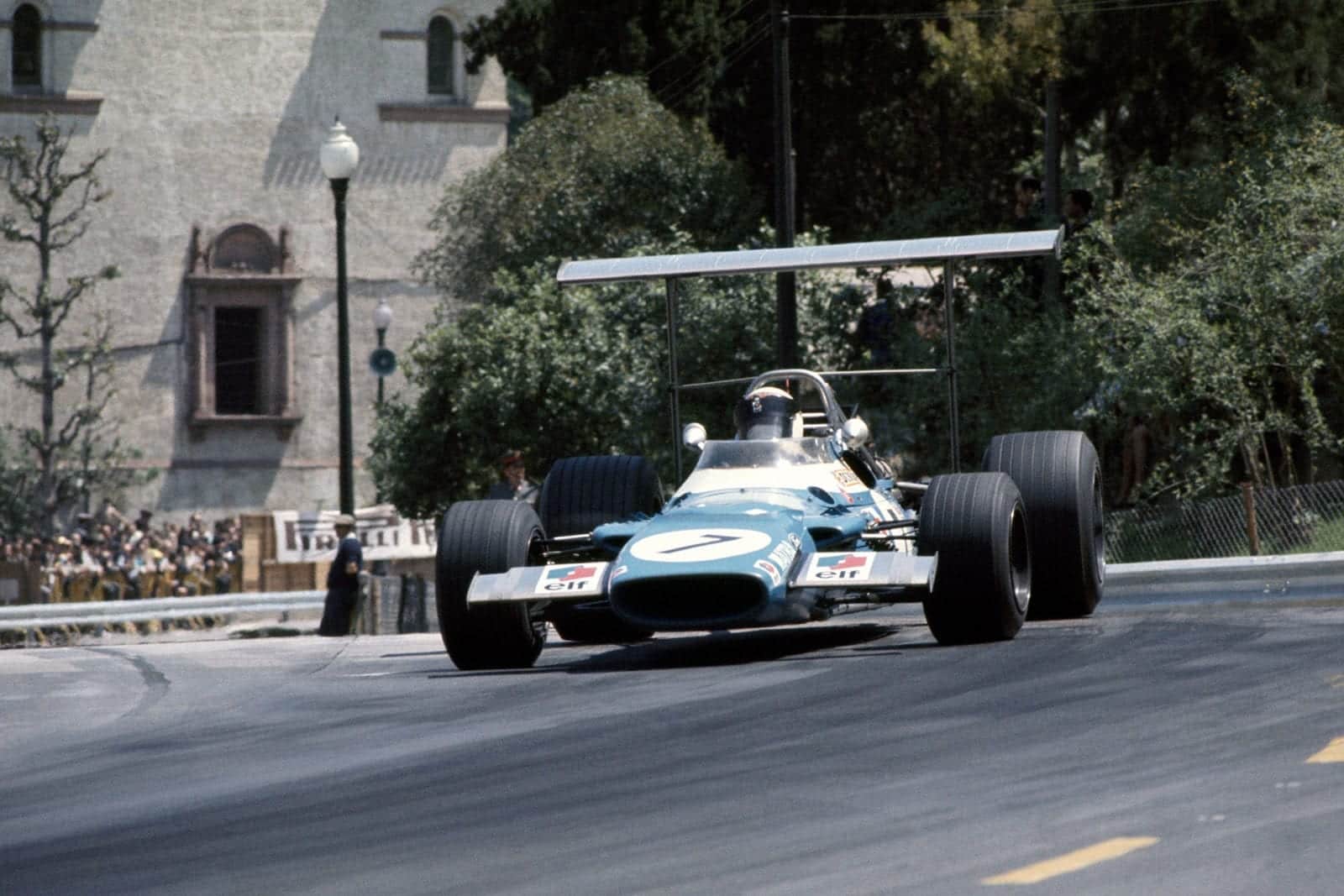
Jackie Stewart took his second consecutive victory for Matra
Motorsport Images
Seasoned readers of Motor Sport will remember that the circuit at Montjuich Park close to the centre of Barcelona was first used for racing as long ago as 1933. But as a result of the Civil War it was not until 1966 that the enthusiastic Real Automovil de Cataluna decided to revive motor racing at this testing 3.8-kilometre circuit.
Formula Two races were held that year and in 1967, while in 1968 an additional 6-hour sports-car race was added to the programme. But the ambition of the club was very much to run the Spanish GP, and with the unpopularity of the Jarama track at Madrid, the Barcelona people lost no time in staking their claim for 1969.
So the Spanish GP came North for this year and the circuit had been considerably updated to bring it up to GPDA standards. The road had been re-surfaced in many places, while the complete length of the track, both inside and out, had been lined with Armco barrier, which later was to prove well worth the expenditure.
The Spanish GP has been run spasmodically through the years, starting in 1913 at a road course in Madrid. Then for a while in the late ‘twenties and early ‘thirties the race was held at San Sebastian.
The next Spanish GP was on the Pedrables road circuit in Barcelona in 1951, and the same venue was used again in 1954. The title was not revived until 1967 for a non-championship race at Jarama, but last year a points-counting race at that circuit opened the European Section of the Championship.
Montjuich Park is situated on the side of a hill and is a well known tourist attraction. From the top of the Park, which itself has come in for considerable revamping during the past year, one can see Barcelona stretched out below—a truly magnificent sight. In the confines of the Park itself one can find a model Spanish Village, a rather dilapidated Olympic Stadium, a huge new amusement park and so on.
The race track is formed out of public roads which run round the park, rather like the carriage road of London’s Regents Park—imagine a race there! From the start line the road rises gently to a crest, then dives dawn quickly to a hairpin left. A couple of nasty curves brings the road sharply downhill to another hairpin. Again dropping steeply, the road falls to the level of the town through three difficult bends.
The road then runs straight past a huge palace, and then starts to climb again through a fast sweeping left-hander. A similar right-hander is immediately followed by another longer left-hand swerve which goes on all the way to the top of the hill before a right kink takes the cars back on to the start and finish straight.
Although the pits are not permanent, they are quite the best which could be erected from scaffolding, and behind them, in the spacious paddock, a new building for the Press was partly constructed: it included such luxuries as a swimming pool. Drivers, entrants, the Trade and the Press were unanimous in their approval of this new addition to the ranks of World Championship circuits. The only bugbears seem to be that the Spanish customs officers still make it very difficult to bring a racing car into the country and the police are rather stupid in their marshalling of the pits.
The number of people who can afford to be involved in World Championship Formula One racing seems to have dwindled this year and only six works teams and three private entries fielded cars. Earlier in the year, it was expected that both Lotus and Matra would have produced their respective four-wheel-drive cars for this race, but this was not to be and most teams brought their 1968 models.
An exception to this rule was Ken Tyrrell’s Matra International team, which had two 1969 MS80 models. Stewart was to drive the car in which he won the Brands Hatch Race of Champions, and there was a brand new but identical car for Beltoise. A last year’s MS10, the car used by Stewart at Silverstone, was held in reserve. The MS80s had flatter fibreglass nose sections than before, but apart from that were unchanged because the French missile firm which builds the cars is working flat out on the 4wd car.
Gold Leaf-Team Lotus arrived with the two regular 49Bs for Hill and Rindt in much the same trim as before, although a third car which was used by Rindt in the Tasman Series was held in reserve. Much activity centred on extending the Lotus’ aerofoils and this continued throughout practice.
Ferrari had decided to put all their efforts into just one car for Amon. This was the latest 1969 machine which made its first appearance in South Africa and then went rather poorly at Silverstone. Since then Ferrari had put in considerable development time, both on the new outside-exhaust engine and the chassis. Amon had instructions that he could now run the V12 engine up to 11,500rpm and soon there were some worried faces in those damps using the Cosworth V8 engines. Ferrari remains alone in using rear aerofoils mounted on the chassis rather than the suspension.
The Owen Racing Organisation is having some teething troubles with the new 48-valve V12 engines, but after the end of the meeting everyone in the BRM camp looked much happier. For the first time BRM fielded two cars fitted with the new engines and for the first time the 48-valve engine started a race. The cars were last year’s chassis, the later P138 for Surtees and the older P133 for Oliver. Oliver’s car was fitted with a Hewland gearbox, although the Surtees car retained a BRM box, as the Hewland, which Surtees prefers, cannot be fitted without modification to the back of the chassis.
Ron Tauranac and the Motor Racing Developments team had made some worthwhile detail modifications to their two 1968 Brabham BT26s, in preparation for the pounding they were expecting at this circuit and later in the month at Monaco. The Hewland FG gearbox had been replaced by the heftier DG and the combined water and oil radiator had been replaced by a full-width water radiator. The cooling of the oil was now looked after by a gearbox-mounted oil radiator with a fibreglass duct around it. The front suspension on Ickx’s car had been brought to the same specification as that used by Brabham at Silverstone.
McLaren Racing, perhaps technically the most advanced of the British Formula One teams, did not have anything new to show apart from a nice new front wheel. They brought their three cars but only used the two seen at Silverstone. The original M7A was again in the hands of Hulme, while the 1969 interim car, based on the Formula A monocoque and first seen at Silverstone, was on hand for McLaren.
The three private entrants all appeared with their regular cars. There was a Lotus 49B for Siffert from Walker/Durlacher, a Brabham BT26 for Courage from Frank Williams and a BRM P126 for Rodriguez from a disconsolate Tim Parnell, whose car still had a rather underpowered 24-valve BRM engine.
Qualifying
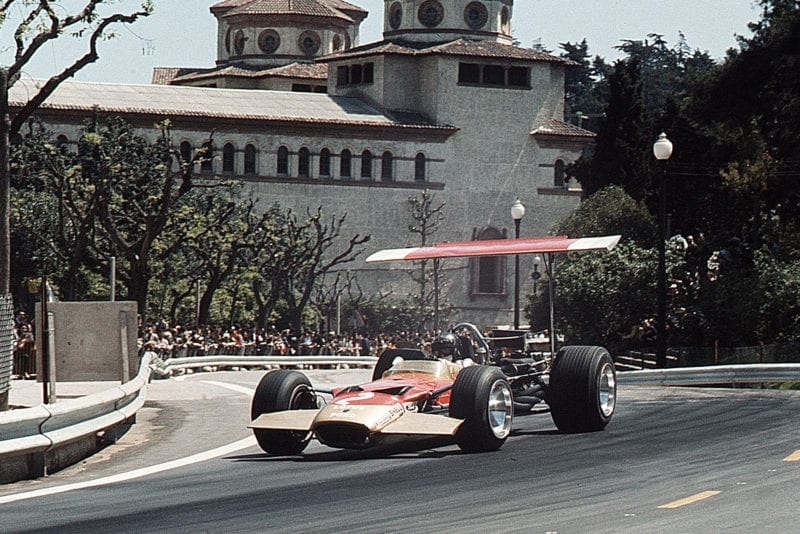
Jochen Rindt claimed pole for Lotus
Motorsport Images
Practice was restricted to three shorter-than-average sessions in the afternoons of Thursday, Friday and Saturday. All the times are shown in the table. The talking point of the first session was the speed of Amon’s Ferrari. The lap record stood to Rindt at 1min 33.3sec recorded in a Formula Two Brabham last year, but Amon, who knew the circuit, was soon under that figure and set the pace with a lap in 1min 27.6sec.
“Rindt ran over a stray dog after about three laps and the incident damaged the suspension of the Lotus”
Hill was also under the 1min 30.0sec mark, as was a far from happy Stewart. Ickx’s practice only lasted half a lap, for a fuel pressure relief valve jammed. Rindt ran over a stray dog after about three laps and the incident damaged the suspension of the Lotus. Courage’s car was a late starter and failed to arrive from England until Friday, while the BRMs were plagued with gear selection problems which were eventually sorted out.
On Friday Amon again showed the speed of the Ferrari by making exactly the same time as on the previous day. Hill was on top form and equalled Amon’s time, but team-mate Rindt was unhappy with his car’s handling and had the shock-absorbers checked, although Armstrong found nothing amiss with them. Stewart was still complaining of poor response on pick-up from his Matra and was well under 1min 30sec. Brabham had a moment, and clipped the Armco barrier, so his car was out of action for a while. Both the BRMs seemed to be steadily improving.
But all the action came on Saturday when every single car improved on previous times. Amon was soon down in the low 1min 27sec mark, for the Ferrari had been fitted overnight with a new engine said to be 5bhp more powerful. Once Amon had come in, Rindt went out and was soon into the 1min 26sec bracket, while team-mate Hill was close behind.
No sooner had the Lotuses come in than the Ferrari was out again and this time Amon was on ten-tenths to record 1min 26.2sec. Well satisfied, the Ferrari team pushed the car back into the paddock. Lotus had not finished yet and whilst they were tacking extra hits on Hill’s wing Rindt went out and lowered his time to a staggering 1min 25.7sec. No one was going to better that!
Stewart was not having a happy session, for the pick-up problem was still there and he tried Beltoise’s car, which seemed better in this respect. Meanwhile, Beltoise did a few laps in the MS10, but the Tyrrell team decided to stick to the original cars for the race and a slightly less powerful 8-series engine was fitted overnight.
Nevertheless Stewart ended up with fourth fastest time. Brabham worked away and lowered his time to 1min 27.8sec. Siffert, Ickx and Hulme finished up with row 3 positions. The two BRMs formed the next row, although Surtees lost considerable time changing gear ratios during the final session. Several teams had fitted additional side tanks to their cars, because in some cases the capacity was marginal.
Race
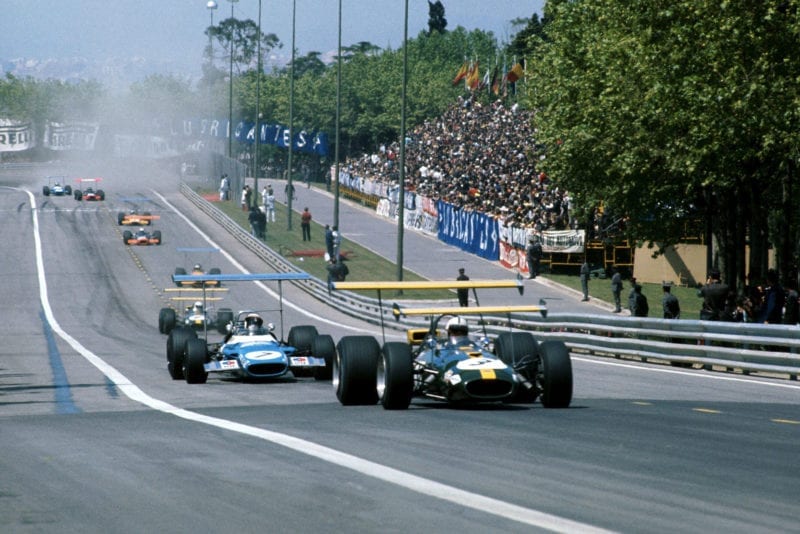
Jack Brabham leads Jackie Stewart on the first lap
Motorsport Images
The race had interesting prospects, for on the front row were two drivers who have yet to win a World Championship race lined up against a twice World Champion.
The weather proved fine, if not sweltering, and a large number of Spaniards had turned up to watch the fun. The formalities were restricted to some girls parading up and down with National flags.
“Oliver rushed off with the car spreading oil round the track”
The cars were lined up on the dummy-grid before the warming-up lap when a mechanic suddenly discovered a pool of oil under Oliver’s car. An oil pipe from the scavenge pump had split, but Oliver did not know, and a policeman restrained the mechanic from telling Oliver for a reason best known only to himself, and Oliver rushed off with the car spreading oil round the track. He came straight into the pits hoping a repair could be effected.
Meanwhile there was a panic around Stewart’s car: the newly-fitted engine was not running evenly, so a new transistorised ignition box was fitted, the plugs were changed and the mixture richened up. There was a second warming-up lap and eventually, half an hour late, the cars were beckoned to roll forward to the main grid and they were off with Rindt taking the lead.
Only 12 went, for Oliver’s car was still in the pit road, while Courage’s starter motor had seized and he could not start his engine. There was a running battle between police and mechanics before he was allowed to be push-started.
By the time the crowd had recovered from this excitement, Rindt stormed past the pits with a considerable lead over Amon, who had Siffert, Hill and Brabham in his wake. After all the drama, Stewart had not made a very good start, so was sixth ahead of Ickx, Hulme, Surtees, McLaren, Rodriguez and Beltoise, with Courage coming round half a lap later. Oliver’s car then left the pits, but returned at the end of the lap to retire because the split pipe needed more time for repairs.
Rindt was trying right from the start to exploit his advantage and by lap 3 had opened up a lead of some 2sec on Amon. This gradually started to increase with each lap, so that by lap 7 it was something like 4sec. But Amon had pulled away from the others, now led by Hill. But the Champion’s lead was short-lived, for on the next lap, as he crested the rise down to the first hairpin, the car careered madly out of control. It finished up wrecked against the Armco barrier, Hill stepping out unhurt. Something had obviously broken, although at the time Hill was not sure what it was.
Surtees pulled into the pits to have an adjustment made to the fuel metering unit, as the engine was not running properly, and returned a few laps later. This time the transistor ignition unit was changed, and when the car re-entered the race after losing about four laps it ran the rest of the distance sounding much healthier. Courage, who was picking up a few places at the end of the field, retired with a broken valve spring on his Cosworth engine, and then on lap 20 we had the dramatic exit of the leading Lotus.
“At the same spot as Hill, the Rindt Lotus had exactly the same accident, suddenly flying out of control”
At almost the same spot where Hill had lost control, the Rindt Lotus had exactly the same accident, suddenly flying out of control. This time, however, his rear aerofoil had been seen to collapse. Rindt’s car—which was travelling at 140mph—smashed into the Armco barrier, then ricocheted off the wreckage of Hill’s car and finally overturned, trapping the luckless driver inside. Somehow he survived this staggering accident and was removed to hospital with nasty cuts and abrasions to his face.
So Amon, from being 7sec in arrears (though perhaps closing slightly), now had a lead of some 25sec over Siffert. The Ferrari was rapidly increasing its lead but Siffert had Stewart closing on him. The Scot had not, however, caught the Swiss, when on lap 20 the Walker Lotus blew up when an oil pump broke.
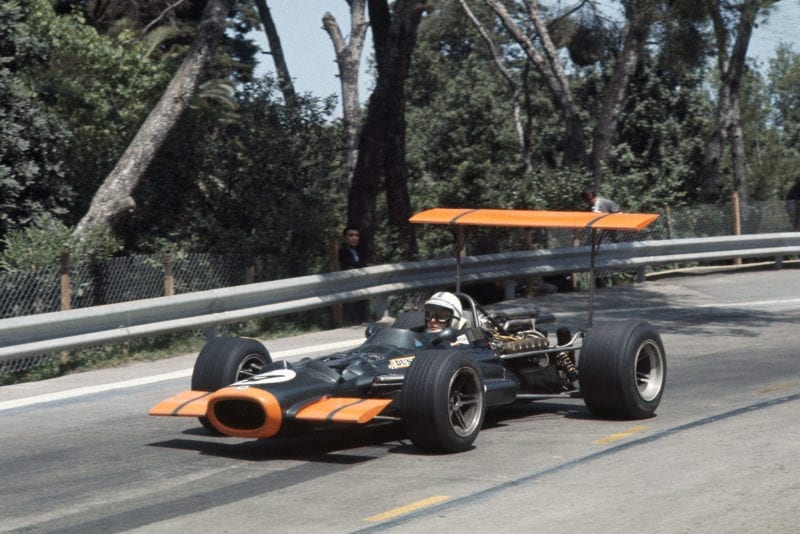
John Surtees finished 5th for BRM
Motorsport Images
So the order was now Amon with a large lead over Stewart, followed by Brabham and Ickx (who were travelling in close convoy), with McLaren fifth. The last-named had been travelling in convoy with team-mate Hulme, but then Hulme had a pit stop to investigate the handling of his car and dropped behind all but Surtees.
The race entered middle distance with little change but Amon still increased the lead. On lap 51 Brabham’s run came to a halt when his engine broke a connecting-rod which holed the cylinder block, so McLaren moved up to fourth behind Ickx. Soon after Beltoise made a couple of pit stops to have his gear linkage attended to but did not lose any places over this, while further down the field Hulme was now motoring to great effect.
“All of a sudden the engine note changed, there was a great puff of smoke and he cruised the Ferrari to a stop at the side of the road”
Amon’s lead looked very secure at 40sec, and he was able to back off and let Stewart close a little, and still have things well in hand. That was until he crossed the line on the 56th lap. All of a sudden the engine note changed, there was a great puff of smoke and he cruised the Ferrari to a stop at the side of the road. There were a lot of unhappy looking Italians and it was thought that the trouble was probably damaged bearings causing the engine to seize.
So Stewart became the race’s third leader, though with a less than 100% engine he was using 1,000rpm below the permitted maximum. Ickx was now in second place well ahead of McLaren, Beltoise, Hulme, Rodriguez and Surtees. But these positions were not to last for long. As he passed the pits, Ickx’s fibreglass wing section flew apart; he did a lap with only odd bits attached to the struts, then came in to the pits. Another fibreglass wing was fitted but he then lost time having to be push-started. Still, he rejoined the race, losing only one place.
“So Stewart became the race’s third leader, though with a less than 100% engine”
Stewart’s lead was over a lap and he was closing on McLaren at quite a rate to increase the gap so that it would soon be two laps.
Hulme looked as if he was going to catch Beltoise for fourth place but the Frenchman managed to speed up considerably and fought off the challenge. The mechanical carnage was not yet over, for with 18 laps remaining, Rodriguez’ Parnell BRM blew up in front of the pits when a piston broke.
Stewart reeled off the remaining laps with regularity and there seemed little doubt that the finishing order behind him would read: McLaren, Ickx, Beltoise, Hulme, Surtees. But with just five laps to go Ickx limped into the pits. The Brabham’s lower rear wishbone had broken a weld on one side of the rear suspension and on the other side the upright was breaking up. Nothing could be done, so the car was retired.
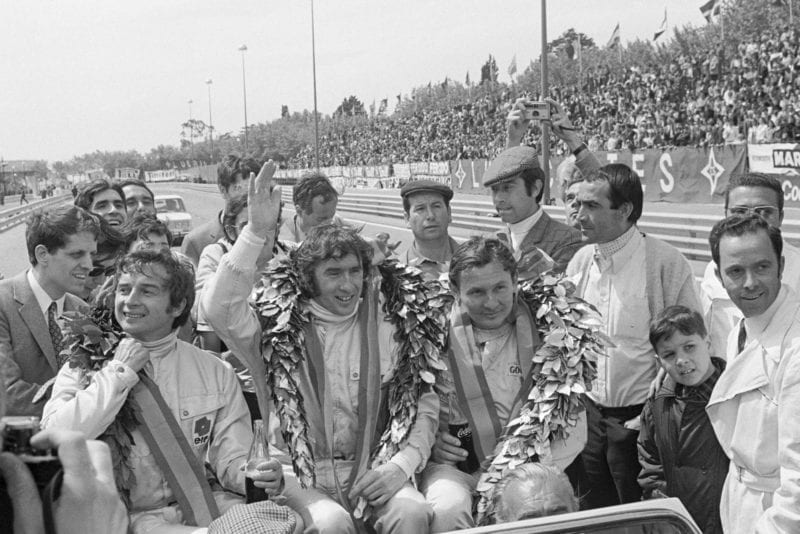
Stewart celebrates his victory
Motorsport Images
The remaining laps were completed without drama, with Stewart finishing to take nine World Championship points in addition to the nine he scored at Kyalami. Second was McLaren, the only other to go the distance without stopping. Beltoise, Hulme and Surtees completed the finishers and Ickx was not classified by the organisers.
Again, apart from Matra International and McLaren Racing, the cars had proved fragile. The race was a good one from both teams and a not unhappy outing for Surtees in the BRM Ferrari has shown that they definitely will be a force to be reckoned with this season, so maybe it will not be a year dominated by Cosworth DFV engines after all. But, most important, the race had shown the dangers of aerofoils when they break—the FIA may well ban them within the next few weeks. [Why didn’t they ban wheels when these used to detach themselves from racing machinery?—Ed.]
